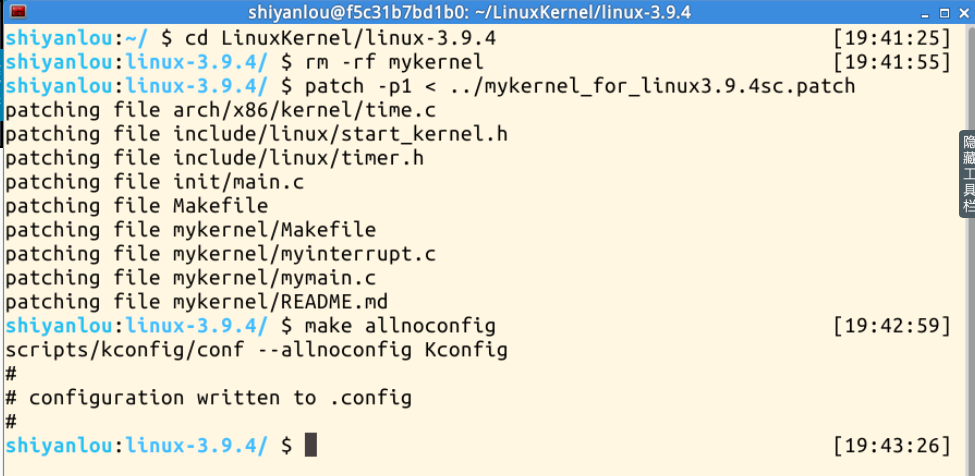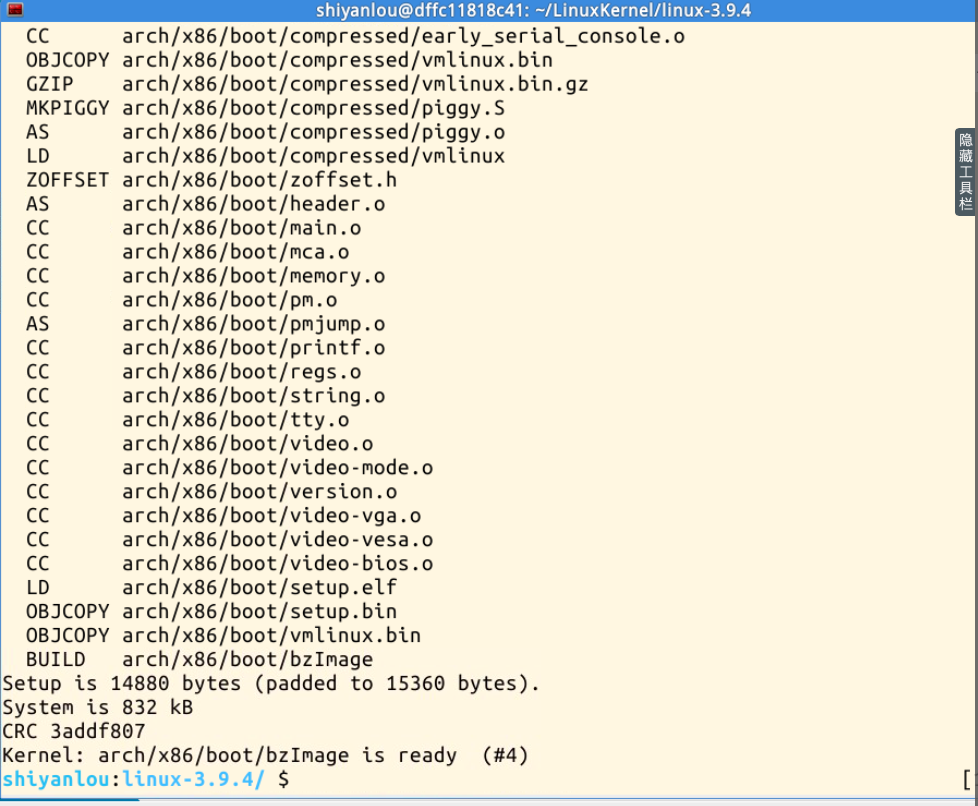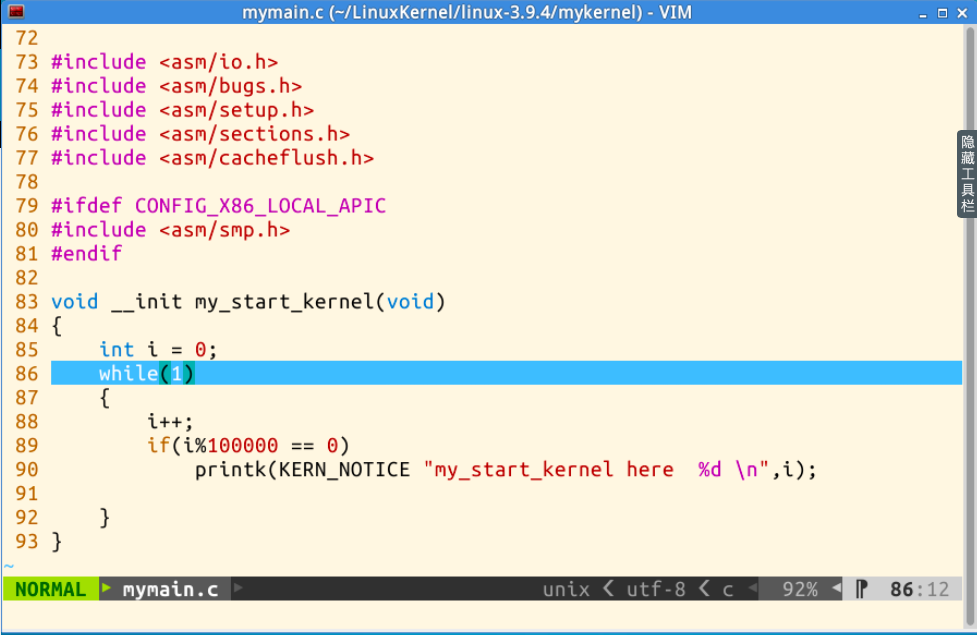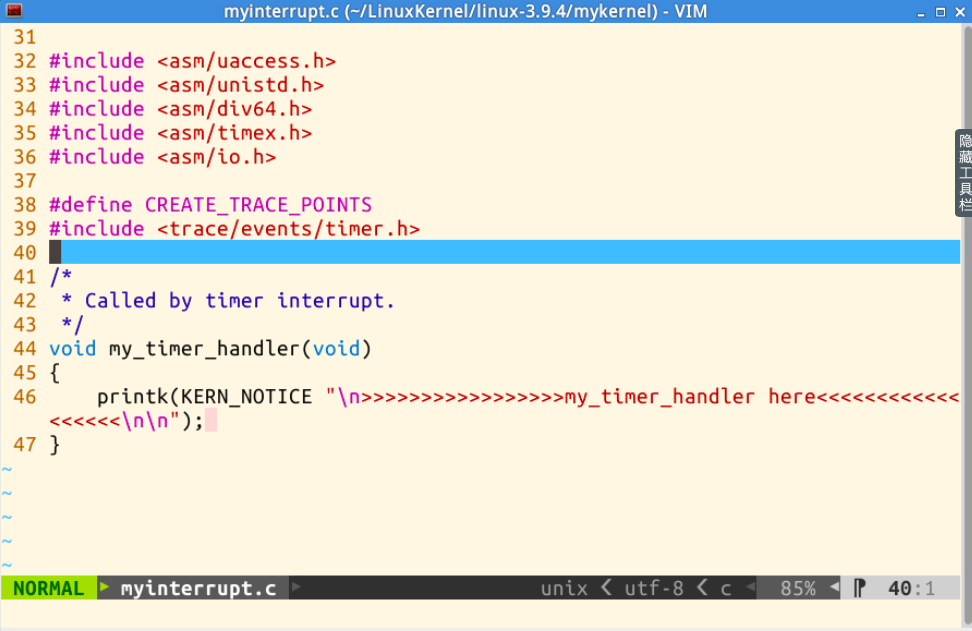基于mykernel完成多进程的简单内核
学号076,本实验资源来源
1.实验准备:https://github.com/mengning/mykernel
由于在pc上总是装不好qemu,所以采用实验楼配置好的虚拟机进行实验。
打开虚拟机的终端,依次输入以下命令:
cd LinuxKernel/linux-3.9.4
rm -rf mykernel
patch -p1 < ../mykernel_for_linux3.9.4sc.patch
make allnoconfig
结果如下:
再输入命令make,进行内核编译,结果如下:

在终端输入命令qemu -kernel arch/x86/boot/bzImage,结果如下图所示:

关闭QEMU窗口,终端输入cd mykernel,再输入ls可以查看mykernel文件夹里的内容,可以看到里面包含mymain.c以及myinterrupt.c
输入vim mymain.c,可以看到mymain.c的内容如下:

my_start_kernel函数中有一个循环,不停地输出my_start_kernel here,同理在终端输入vim myinterrupt.c,可以看到myinterrupt.c的内容如下:

my_timer_handler函数会被时钟中断周期调用,输出类似>>>>>my_timer_handler here <<<<< 的字符串。
2.一个简单的时间片轮转多道程序
(1)步骤:
将https://github.com/mengning/mykernel下的mypcb.h、mymain.c和myinterrupt.c复制到mykernel目录下,取代原来的myinterrupt.c、mymain.c。对myinterrupt.c、mymain.c的内容进行修改,具体代码后面会进行相关描述,在终端输入命令make编译内核,编译完成后,输入命令qemu -kernel arch/x86/boot/bzImage运行内核程序,运行结果如下图所示:

(2)源代码分析
这里主要分析上面复制的3个文件,其作用简述如下:
mypcb.h : 进程控制块PCB结构体定义。
mymain.c: 初始化各个进程并启动0号进程。
myinterrupt.c:时钟中断处理和进程调度算法。
详细分析:首先分析mypcb.h,代码如下:
/*
* linux/mykernel/mypcb.h
*
* Kernel internal PCB types
*
* Copyright (C) 2013 Mengning
*
*/
#define MAX_TASK_NUM 4
#define KERNEL_STACK_SIZE 1024*8
/* CPU-specific state of this task */
struct Thread {
unsigned long ip;
unsigned long sp;
};
typedef struct PCB{
int pid;
volatile long state; /* -1 unrunnable, 0 runnable, >0 stopped */
char stack[KERNEL_STACK_SIZE];
/* CPU-specific state of this task */
struct Thread thread;
unsigned long task_entry;
struct PCB *next;
}tPCB;
void my_schedule(void);
结构体Thread 结构体,用于存储当前进程中正在执行的线程的ip和sp,PCB结构体中的各个字段含义如下
pid:进程号
state:进程状态,-1表示就绪态,0表示运行态,大于0表示阻塞态
stack:进程使用的堆栈
thread:当前正在执行的线程信息
task_entry:进程入口函数
next:指向下一个PCB,模拟系统中所有的PCB是以链表的形式组织起来的。
函数声明 my_schedule,它的实现是在my_interrupt.c中,在mymain.c中的各个进程函数会根据一个全局变量的状态来决定是否调用它,从而实现主动调度。
接着分析mymain.c,代码如下:
/*
* linux/mykernel/mymain.c
*
* Kernel internal my_start_kernel
*
* Copyright (C) 2013 Mengning
*
*/
#include <linux/types.h>
#include <linux/string.h>
#include <linux/ctype.h>
#include <linux/tty.h>
#include <linux/vmalloc.h>
#include "mypcb.h"
tPCB task[MAX_TASK_NUM];
tPCB * my_current_task = NULL;
volatile int my_need_sched = 0;
void my_process(void);
void __init my_start_kernel(void)
{
int pid = 0;
int i;
/* Initialize process 0*/
task[pid].pid = pid;
task[pid].state = 0;/* -1 unrunnable, 0 runnable, >0 stopped */
task[pid].task_entry = task[pid].thread.ip = (unsigned long)my_process;
task[pid].thread.sp = (unsigned long)&task[pid].stack[KERNEL_STACK_SIZE-1];
task[pid].next = &task[pid];
/*fork more process */
for(i=1;i<MAX_TASK_NUM;i++)
{
memcpy(&task[i],&task[0],sizeof(tPCB));
task[i].pid = i;
task[i].state = -1;
task[i].thread.sp = (unsigned long)&task[i].stack[KERNEL_STACK_SIZE-1];
task[i].next = task[i-1].next;
task[i-1].next = &task[i];
}
/* start process 0 by task[0] */
pid = 0;
my_current_task = &task[pid];
asm volatile(
"movl %1,%%esp\n\t" /* set task[pid].thread.sp to esp */
"pushl %1\n\t" /* push ebp */
"pushl %0\n\t" /* push task[pid].thread.ip */
"ret\n\t" /* pop task[pid].thread.ip to eip */
"popl %%ebp\n\t"
:
: "c" (task[pid].thread.ip),"d" (task[pid].thread.sp) /* input c or d mean %ecx/%edx*/
);
}
void my_process(void)
{
int i = 0;
while(1)
{
i++;
if(i%10000000 == 0)
{
printk(KERN_NOTICE "this is process %d -\n",my_current_task->pid);
if(my_need_sched == 1)
{
my_need_sched = 0;
my_schedule();
}
printk(KERN_NOTICE "this is process %d +\n",my_current_task->pid);
}
}
}
系统启动后最先调用函数 my_start_kernel ,完成了0号进程的初始化和启动,并创建了其它的进程PCB便于调度。my_process 函数在执行的时候,会打印出当前进程的 id,从而使得我们能够看到当前哪个进程正在执行。
另外,在 my_process 也会检查一个全局标志变量 my_need_sched,一旦发现其值为 1 ,就调用 my_schedule 完成进程的调度。
0号线程的启动,嵌入了汇编代码,详细参见源码中的注释。
最后,分析myinterrupt.c,代码如下:
/*
* linux/mykernel/myinterrupt.c
*
* Kernel internal my_timer_handler
*
* Copyright (C) 2013 Mengning
*
*/
#include <linux/types.h>
#include <linux/string.h>
#include <linux/ctype.h>
#include <linux/tty.h>
#include <linux/vmalloc.h>
#include "mypcb.h"
extern tPCB task[MAX_TASK_NUM];
extern tPCB * my_current_task;
extern volatile int my_need_sched;
volatile int time_count = 0;
/*
* Called by timer interrupt.
* it runs in the name of current running process,
* so it use kernel stack of current running process
*/
void my_timer_handler(void)
{
#if 1
if(time_count%1000 == 0 && my_need_sched != 1)
{
printk(KERN_NOTICE ">>>my_timer_handler here<<<\n");
my_need_sched = 1;
}
time_count ++ ;
#endif
return;
}
void my_schedule(void)
{
tPCB * next;
tPCB * prev;
if(my_current_task == NULL
|| my_current_task->next == NULL)
{
return;
}
printk(KERN_NOTICE ">>>my_schedule<<<\n");
/* schedule */
next = my_current_task->next;
prev = my_current_task;
if(next->state == 0)/* -1 unrunnable, 0 runnable, >0 stopped */
{
/* switch to next process */
asm volatile(
"pushl %%ebp\n\t" /* save ebp */
"movl %%esp,%0\n\t" /* save esp */
"movl %2,%%esp\n\t" /* restore esp */
"movl $1f,%1\n\t" /* save eip */
"pushl %3\n\t"
"ret\n\t" /* restore eip */
"1:\t" /* next process start here */
"popl %%ebp\n\t"
: "=m" (prev->thread.sp),"=m" (prev->thread.ip)
: "m" (next->thread.sp),"m" (next->thread.ip)
);
my_current_task = next;
printk(KERN_NOTICE ">>>switch %d to %d<<<\n",prev->pid,next->pid);
}
else
{
next->state = 0;
my_current_task = next;
printk(KERN_NOTICE ">>>switch %d to %d<<<\n",prev->pid,next->pid);
/* switch to new process */
asm volatile(
"pushl %%ebp\n\t" /* save ebp */
"movl %%esp,%0\n\t" /* save esp */
"movl %2,%%esp\n\t" /* restore esp */
"movl %2,%%ebp\n\t" /* restore ebp */
"movl $1f,%1\n\t" /* save eip */
"pushl %3\n\t"
"ret\n\t" /* restore eip */
: "=m" (prev->thread.sp),"=m" (prev->thread.ip)
: "m" (next->thread.sp),"m" (next->thread.ip)
);
}
return;
}
my_timer_handler 函数会被内核周期性的调用,每调用1000次,就去将全局变量my_need_sched的值修改为1,通知正在执行的进程执行调度程序my_schedule。在my_schedule函数中,完成进程的切换。进程的切换分两种情况,一种情况是下一个进程没有被调度过,另外一种情况是下一个进程被调度过,可以通过下一个进程的state知道其状态。进程切换依然是通过内嵌汇编代码实现,无非是保存旧进程的eip和堆栈,将新进程的eip和堆栈的值存入对应的寄存器中,详见代码中的注释。
3.总结
通过此次实验可以得出:现代操作系统的核心是进程的调度与中断机制,需要利用堆栈空间,通过esp堆栈指针寄存器、ebp基址指针寄存器和cs:eip寄存器等关键寄存器来保存和恢复现场,进行进程上下文的切换。进程的切换需要与计算机的硬件相配合,操作系统通过进程的中断与切换使CPU时间合理分配,保证计算机的性能发挥。

